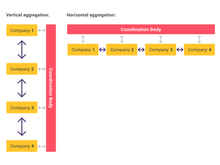In the field of management, strategic management involves the formulation and implementation of the major goals and initiatives taken by an organization's managers on behalf of stakeholders, based on consideration of resources and an assessment of the internal and external environments in which the organization operates. Strategic management provides overall direction to an enterprise and involves specifying the organization's objectives, developing policies and plans to achieve those objectives, and then allocating resources to implement the plans. Academics and practicing managers have developed numerous models and frameworks to assist in strategic decision-making in the context of complex environments and competitive dynamics. Strategic management is not static in nature; the models can include a feedback loop to monitor execution and to inform the next round of planning.
Marketing management is the strategic organizational discipline which focuses on the practical application of marketing orientation, techniques and methods inside enterprises and organizations and on the management of a firm's marketing resources and activities.
A cross-functional team (XFN), also known as a multidisciplinary team or interdisciplinary team, is a group of people with different functional expertise working toward a common goal. It may include people from finance, marketing, operations, and human resources departments. Typically, it includes employees from all levels of an organization. Members may also come from outside an organization.
Marketing strategy is an organization's promotional efforts to allocate its resources across a wide range of platforms and channels to increase its sales and achieve sustainable competitive advantage within its corresponding market.
Coopetition or co-opetition is a neologism coined to describe cooperative competition. Coopetition is a portmanteau of cooperation and competition. Basic principles of co-opetitive structures have been described in game theory, a scientific field that received more attention with the book Theory of Games and Economic Behavior in 1944 and the works of John Forbes Nash on non-cooperative games. Coopetition occurs both at inter-organizational or intra-organizational levels.
A strategic alliance is an agreement between two or more parties to pursue a set of agreed upon objectives needed while remaining independent organizations.

Design management is a field of inquiry that uses design, strategy, project management and supply chain techniques to control a creative process, support a culture of creativity, and build a structure and organization for design. The objective of design management is to develop and maintain an efficient business environment in which an organization can achieve its strategic and mission goals through design. Design management is a comprehensive activity at all levels of business, from the discovery phase to the execution phase. "Simply put, design management is the business side of design. Design management encompasses the ongoing processes, business decisions, and strategies that enable innovation and create effectively-designed products, services, communications, environments, and brands that enhance our quality of life and provide organizational success." The discipline of design management overlaps with marketing management, operations management, and strategic management.
Strategic communication can mean either communicating a concept, a process, or data that satisfies a long-term strategic goal of an organization by allowing facilitation of advanced planning, or communicating over long distances usually using international telecommunications or dedicated global network assets to coordinate actions and activities of operationally significant commercial, non-commercial and military business or combat and logistic subunits. It can also mean the related function within an organization, which handles internal and external communication processes. Strategic communication can also be used for political warfare.
The following outline is provided as an overview of and topical guide to marketing:
Business partnering is the development of successful, long term, strategic relationships between customers and suppliers, based on achieving best practice and sustainable competitive advantage. The term also refers to a business partnering support service model, where professionals such as HR staff work closely with business leaders and line managers to achieve shared organisational objectives. In practice, the business partner model can be broadened to include members of any business function, for example, Finance, IT, HR, Legal, External Relations, who act as a connector, linking their function with business units to ensure that the technical, or functional, expertise they have to offer is placed within the real and current concerns of the business to create value.
New business development concerns all the activities involved in the creation of a new enterprise and in realizing new business opportunities, including product or service design, business model design, and marketing.
Corporate venture capital (CVC) is the investment of corporate funds directly in external startup companies. CVC is defined by the Business Dictionary as the "practice where a large firm takes an equity stake in a small but innovative or specialist firm, to which it may also provide management and marketing expertise; the objective is to gain a specific competitive advantage." Examples of CVCs include GV and Intel Capital.

The Manufacturers’ Association of Israel (MAI) is the umbrella organization and representative body of all industrial sectors in Israel including the private, public, kibbutz, and government industries. With a membership of over 1,800 organizations responsible for more than 90% of the industrial output, the Manufacturers’ Association of Israel is the largest and most influential economic organization in the country. Dr. Ron Tomer has led the organization as President since January 30, 2020. Headquartered in Tel Aviv, the Manufacturers’ Association of Israel has three other regional branches. The Northern branch, located in the city of Haifa, serves over 600 different member organizations which are responsible for around one third of all the industrial manpower in Israel. The Jerusalem branch, located in the city of Jerusalem, serves over 130 different member organizations. The Southern branch, located near the city of Be’er Sheva, serves over 350 different member organizations.
The European Aerospace Cluster Partnership (EACP) is a permanent partnership between collaborating European aerospace clusters. The consortium currently comprises 45 aerospace clusters from 18 different countries and was initiated by the city of Hamburg in 2009 and co-funded by the European Commission.
Kjell Grønhaug is a Norwegian organizational theorist, management consultant and Professor emeritus of Business Administration at the Norwegian School of Economics and Business Administration.

The University of Valencia Science Park provides spaces and services to companies resulting from university research, –spin-off–, and other companies and R & D departments with content related to the innovative nature of the PCUV.
The Industrial Marketing and Purchasing Group or International Marketing and Purchasing Group is a European research initiative in the field of Industrial marketing established in 1976 by researchers from different countries and universities in Europe. It has evolved into an "informal international group of scholars concerned with developing concepts and knowledge in the field of business-to-business marketing and purchasing." The group is also called the Nordic school of marketing.
Lars-Erik Gadde is a Swedish organizational theorist and Professor of Technology Management and Economics at Chalmers University of Technology in Gothenburg, Sweden. He is known for his work on business networks, professional purchasing. and case study research.
Bjorn Axelsson is a Swedish organizational theorist and Professor of Business Administration at the Stockholm School of Economics, known for his work on industrial networks.
The relationship substance framework is a conceptual model for understanding business-to-business (B2B) relationships, developed and championed by the Industrial Marketing and Purchasing Group and adopted particularly in Scandinavian studies of industrial practice. The IMP Group have proposed that all business relationships are made up of three layers - actor bonds, resource ties and activity links.




